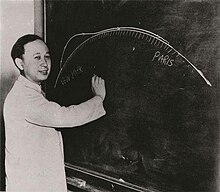Qian Xuesen
Qian Xuesen, or Hsue-Shen Tsien (Chinese: 钱学森; 11 December 1911 – 31 October 2009), was a Chinese mathematician, cyberneticist, aerospace engineer, andphysicist who made significant contributions to the field of aerodynamics and established engineering cybernetics. Recruited from MIT, he joined Theodore von Karman's group at Caltech.[1] During WWII, he was involved in the Manhattan Project, which ultimately led to the successful development of the first atomic bomb in America.[2][3] Later on, he would eventually return to China, where he would make important contributions to China's missile and space program.
During the Second Red Scare, in the 1950s, the US federal government accused him of communist sympathies. In 1950, despite protests by his colleagues, he was stripped of his security clearance.[4] He decided to return to China, but he was detained at Terminal Island, near Los Angeles.[5]
After spending five years under house arrest,[6] he was released in 1955 in exchange for the repatriation of American pilots who had been captured during the Korean War. He left the United States in September 1955 on the American President Lines passenger liner SS President Cleveland, arriving in China via Hong Kong.[7]
Upon his return, he helped lead the Chinese nuclear weapons program.[8] This effort ultimately led to China's first successful atomic bomb test and hydrogen bomb test, making China the fifth nuclear weapons state, and achieving the fastest fission-to-fusion development in history. Additionally, Qian's work led to the development of theDongfeng ballistic missile and the Chinese space program. For his contributions, he became known as the "Father of Chinese Rocketry", nicknamed the "King of Rocketry".[9][10] He is recognized as one of the founding fathers of Two Bombs, One Satellite.[11]
In 1957, Qian was elected an academician of the Chinese Academy of Sciences. He served as a Vice Chairman of the National Committee of the Chinese People's Political Consultative Conference from 1987 to 1998.
He was the cousin of mechanical engineer Hsue-Chu Tsien, who was involved in the aerospace industries of China and the United States; his nephew is Roger Y. Tsien, the 2008 winner of the Nobel Prize in Chemistry.
